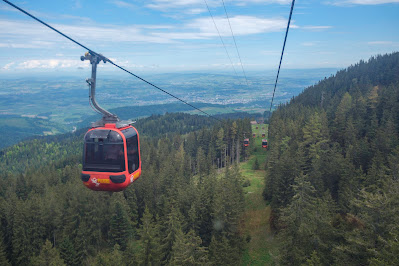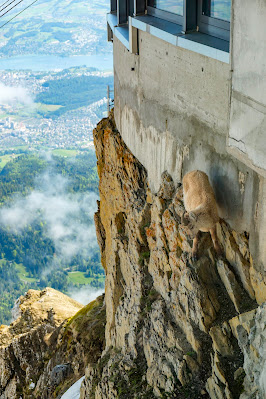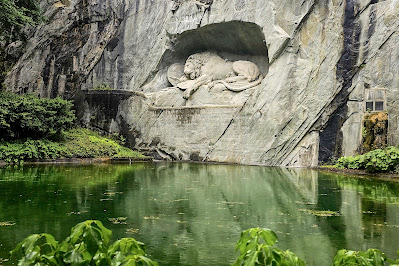Lucerne 2024
This is something you see a LOT of in Switzerland... green, lakes and rivers and mountains
Our train from Venice eventually took Rob and myself to Lucerne, Switzerland for a 3 night stay and what a beautiful city it is, well organised, beautiful lake, high mountains nearby, clean and historical!Lucerne is famous for retaining many medieval structures within it.
 |
| Lucerne is on a lake so we enjoyed it, the nearby Pilatus mountain and the city itself |
We elected to stay in the older section of Lucerne, which meant walking from the railway station, along the edge of the lake of the same name and crossing a normal bridge… more on that later, but stopping constantly to take more photos.
 |
| The city wraps itself around one end of the lake of the same name |
 |
| The water is so clear and the buildings very beautiful |
 |
| This tower was outside our accomodation |
We were tempted back out again at night, again taking yet more photos because this city is just so glorious to look at, at any time of the day or night.
 |
| It was just as stunning at night |
 |
| Many buildings are covered with ornate decorations |
 |
| Some old timber bridges are very prominent in Lucerne... more on them later |
For our first full day in Lucerne, we caught a bus which was very easy, to take cable cars to the top of Pilatus Mountain overlooking the city. It took 3 different cable cars to achieve the last stop and as we climbed higher, the views just expanded further across the alps behind the city and of Lucerne itself.
We also saw the toboggan ride on wheels people were enjoying down part of the mountain, before being towed back to the start point by tow rope… looked like a lot of fun.
 |
| On the first of 3 cable car runs to reach the top |
 |
| View of Lucerne from the first cable car section |
At each cable car change point, there was something for visitors to do and when we reached the top, there was quite a large complex consisting of a hotel, restaurant, cafe and multiple view points to walk to.
 |
| People enjoying themselves part way up the mountain |
 |
| Last cable used to reach the summit with Lucerne in the background |
As we alighted from the last cable car, we soon realised how steep this mountain was with sheer drops on multiple sides and were surprised to see a mountain goat walking around on the edge of it right at the top with us.
 |
| Mountain goat looking for water dripping off the concrete walls |
We certainly enjoyed all the view points, at times having to wait for the cloud below us to blow through, before enjoying more of the vistas.
 |
| Waiting for the clouds to clear |
 |
| There are distant mountains to view from most vantage points |
 |
| There is a hotel and cafes at the summit of Pilatus Mountain |
An alternative to cable cars for reaching the summit, is to take a cogwheel train, which we saw climbing up the side of the mountain from a different direction. There were 2 adventurous people who used hang gliders to descend off the mountain which kept everyone intrigued before they disappeared behind the mountain.
 |
| The alternate cogwheel train for reaching the summit |
 |
| Hang glider leaving the summit |
Back down off the mountain, the rest of our time in Lucerne was dedicated to further exploration around the city, mainly by walking and also taking a short boat cruise on the lake.
 |
| One of the views whilst cruising on the lake |
 |
| Very different views from the lake itself |
Lucerne is famous for 2 old timber bridges, one called the Chapel Bridge, constructed around 1360, which is adorned as you walk through it, with 62 timber panel paintings fixed to the trusses of the roof. It is a covered bridge and about 200 metres long, making it the 2nd longest covered bridge in Europe.
 |
| The Chapel Bridge by day |
 |
| Rob resting during our walk through the bridge |
 |
| Some of the paintings up in the roof |
 |
| One of the paintings throughout the bridge |
There is a 2nd smaller bridge called the Chaff Bridge, built in 1408 which is 81 metres long and takes its name from the chaff which was initially dumped into the Reuss River from the mill which stands dormant nearby.
 |
| Section of the Chaff Bridge |
 |
| The Reuse River entering the lake and church in the background |
Not far away from the Chaff Bridge is a catholic church and we have seen a lot of churches in our time, but this one inside was quite exquisite for its simple beautiful style rather than the obscene wealth some of them put on display.
 |
| Very elegant decorations inside the Jesuitenkirche HI. Franz Xaver |
There is plenty to do in the city, but we restricted ourselves to doing the Musegg Wall walk with its 9 towers as drizzling rain fell, but again well worth it. Some of the walk was along the base of the wall and some was on the wall itself. Built in the 14th century, they were designed to defend the city and each tower is unique in design, one being the Zuitturm or clock tower.
 |
| Decorated Zuitturm clock tower |
 |
| Disused clock mechanism on display |
 |
| Walking atop the old city wall |
Another location which got our attention was the Lion Monument, a sculpture in a rock wall of a dying lion, commemorating the 680 Swiss Guards who were massacred in 1792 in Paris during the French Revolution, when revolutionaries stormed the Tuileries Palace.
 |
| Lion Monument remembering the fallen Swiss Guards |
The rest of our time in Lucerne is hopefully captured via the additional photos found in the link below.
CLICK HERE for more photos of Lucerne
So now this is when things get a little convoluted in that after Lucerne we travelled to France to meet Australian friends Julie & Pete, to do the next part of this section of the trip, something we planned for 2020, but was cancelled due to covid.
Because we did parts of both France and Switzerland with them, will cover the Swiss section now and the France bit as a whole. Apologies for this sidebar explanation, but may put into context who these ‘new’ people are.
Our meeting point was in Strasbourg (more of this in the French post), and from there we took trains to the highly renowned town of St Moritz which was meant to involve 3 trains but one was cancelled after entering Switzerland. New routes were soon found by the railway, but now involved 4 changes but we arrived 1 hour earlier!
St Moritz
St Moritz was somewhat underwhelming, in part because there was no snow except on some nearby mountains we could barely see due to rain and low cloud, significant building work going on everywhere due to it being mid season and a lack of real energy in the town. Most likely during winter, its very different but since it was only an overnight stay, it was what it was.
 |
| When we arrived into St Moritz the alps were 'hiding' |
 |
| Whilst some buildings were okay... St Moritz was missing energy |
During our walk back downhill to the railway station, more scenery was presenting itself with more of a large lake, fog/mist slowly rising off it and behind the lake beautiful snow capped mountains were revealed as the cloud and fog kept lifting. It was great to see considering the main reason for being in Switzerland being a trip on The Glacier Express.
 |
| The rising mist reveal more beautiful scenery |
 |
| The alps were revealed as the mist and fog burnt off |
The Glacier Express
Now we like train travel and you would be excused for perhaps thinking, not another train trip but this is regarded as one of THE train trips of the world.
 |
| On the Glacier Express |
The Glacier Express is also tagged as ‘the slowest fast train’ in the world, travelling 290 kms in 8 hours through the Swiss Alps, between St Moritz in our case and Zermatt... both located in the Swiss Alps
 |
| Our Glacier Express route within Switzerland |
To put it very simply… it was stunning!
 |
| During the trip we passed many small villages nestled in the alps... |
 |
| ...and there were vivid colours! |
 |
| Farmers get great views also |
Throughout the day we also enjoyed the company of some great passengers and everyone was very respectful of enabling others to have time at key windows to take photographs, especially the windows that opened.
Will let photos with their own explanation tell its own story.
 |
| Higher in the Alps amongst the snow and ice |
 |
| Yet another village way below us |
 |
| Nice reflection high in the Alps |
If you ever plan to do the Glacier Express, we strongly recommend you book a ticket using the ‘Man in Seat 61’ website via this link - https://www.seat61.com/trains-and-routes/glacier-express.htm - as it will literally save you hundreds of $$’s.
Zermatt
The train finished in Zermatt at an elevation of 1620 metres, another famous Swiss Alps town and it was great for another overnight stay, lively with lots of people enjoying themselves.
 |
| One the views of Zermatt |
 |
| New tourists wandering their way through Zermatt |
We were picked up from the railway station by the hotel in a very small electric vehicle which barely took all of us and our luggage as normal cars are not allowed in the town. It is quite spread out along a valley and during the season it must really buzz.
 |
| Our EV transport to the hotel |
Zermatt is also famous as the home of a very famous mountain called the Matterhorn, which dominates the background looking like a very jagged tooth and 3,000 people on average, attempt to climb its 4,478 metres each year.
On average, 15 people die each year during their attempt to climb this mountain and over 500 total people have died, some falling into the glacier at the bottom of the mountain, their bodies never recovered!
 |
| Zermatt's cemetery where some of the mountain climbers are buried |
During our visit, the famous mountain was shrouded in cloud at its top, teasing everyone waiting to see its jagged top, which thankfully did appear for us as we were leaving next morning back to the railway station. It is a very impressive and dominant mountain.
 |
| View from Zermatt of the Matterhorn shrouded in cloud |
 |
| Eventually the Matterhorn came out to say hello |
Again to keep this post short and hoping the photos tell their own story, please click on the link below to see photos of our time on the wonderful Glacier Express through the alps.
CLICK HERE for a few more photos of The Glacier Express trip
So by now you know we spent time in parts of France with Julie and Pete, so for more on that if interested, keep your eyes open for our France 2024 post.
Go well!
















































